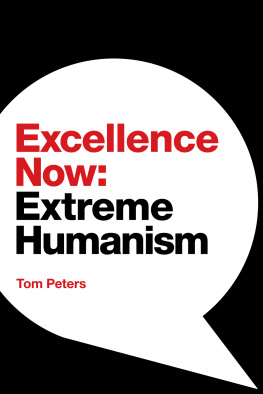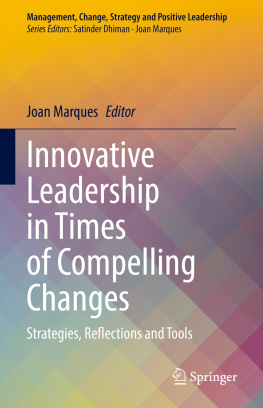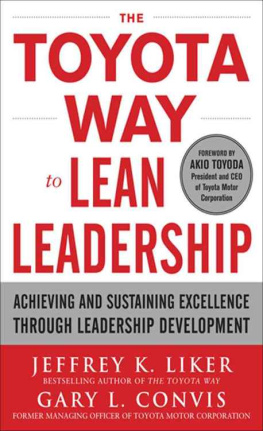The Faade of Excellence
Defining a New Normal of Leadership
The Faade of Excellence
Defining a New Normal of Leadership
by
John Dyer

First edition published in 2020
by Routledge/Productivity Press
52 Vanderbilt Avenue, 11th Floor New York, NY 10017
2 Park Square, Milton Park, Abingdon, Oxon OX14 4RN, UK
2020 by John Dyer
Routledge/Productivity Press is an imprint of Taylor & Francis Group, an Informa business
No claim to original U.S. Government works
Printed on acid-free paper
International Standard Book Number-13: 978-0-367-14533-0 (Hardback)
International Standard Book Number-13: 978-0-429-03218-9 (eBook)
This book contains information obtained from authentic and highly regarded sources. Reasonable efforts have been made to publish reliable data and information, but the author and publisher cannot assume responsibility for the validity of all materials or the consequences of their use. The authors and publishers have attempted to trace the copyright holders of all material reproduced in this publication and apologize to copyright holders if permission to publish in this form has not been obtained. If any copyright material has not been acknowledged please write and let us know so we may rectify in any future reprint.
Except as permitted under U.S. Copyright Law, no part of this book may be reprinted, reproduced, transmitted, or utilized in any form by any electronic, mechanical, or other means, now known or hereafter invented, including photocopying, microfilming, and recording, or in any information storage or retrieval system, without written permission from the publishers.
For permission to photocopy or use material electronically from this work, please access www.copyright.com (http://www.copyright.com/) or contact the Copyright Clearance Center, Inc. (CCC), 222 Rosewood Drive, Danvers, MA 01923, 978-750-8400. CCC is a not-for-profit organization that provides licenses and registration for a variety of users. For organizations that have been granted a photocopy license by the CCC, a separate system of payment has been arranged.
Trademark Notice : Product or corporate names may be trademarks or registered trademarks, and are used only for identification and explanation without intent to infringe.
Visit the Taylor & Francis Web site at
http://www.taylorandfrancis.com
To my wife Keela
She has supported me in all of my endeavors and I love her dearly
To our children David, Danielle, and our son-in-law Kyle
Thank you for your love and encouragement and for being the best family a Dad could hope for
And to all of the improvement professionals:
Keep working on transforming cultures, improving processes, and applying the new normal of leadership in order to give everyone the opportunity to be fulfilled and to experience what it is like to be a part of a winning team
Contents
There are several people who have helped make this book possible who richly deserve recognition.
I thank my wife, Keela, who has proofread every article I have ever written and was the first person to read and provide feedback on each of the chapters in this book. Her perspective has been invaluable.
I appreciate and thank one of my previous bosses, Scott Duncan, who supported trying several of the ideas that are discussed in this book when he was the leader of a business. Over the years, Scott has also proofread everything I have written and has provided a business perspective, and for that I am eternally grateful.
Next, I extend many thanks to the person who gave me my first break in publishing, Jill Jusko, editor at IndustryWeek magazine. She has provided expert guidance and feedback throughout my writing career, and this book would not have been possible without her support.
Finally, I thank the folks at Productivity Press, Michael Sinocchi and Katherine Kadian, who have provided valuable insights into the publishing business and who were willing to take a chance on a little-known author.
John Dyer
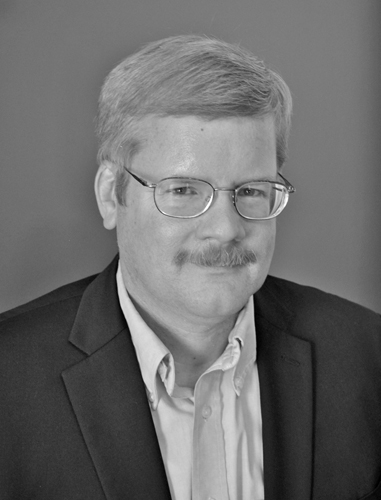
John Dyer has over 3 decades of Continuous Process Improvement experience: 10 years with General Electric, 10 years with Ingersoll-Rand (brand names included: Bobcat, Club Car, Schlage Lock, Thermo-King, and Hussmann), and the rest as President of John Dyer & Associates, Inc. Process Innovations, a company that is focused on helping organizations of all types achieve excellence. He has a B.S. in Electrical Engineering from Tennessee Technological University and an M.S. in Business Management (International MBA) from Purdue University and the University of Rouen, France.
In the early 1990s while at GE, John was given a special assignment: go out and collect best practices in the area of Process Excellence. During this influential time in his career, he studied with Dr. Ed Deming, Brian Joiner (author of the Team Handbook), and attended classes at the Steven Covey Institute of Leadership and participated in the original Six Sigma training provided at Motorola University. From these best practices, John developed several interactive classes and workshops in the area of Continuous Improvement, including how to implement lean and Six Sigma, solve for the root cause of problems, and facilitate teams. After this assignment, the GE executives asked John to implement what he had learned. These experiences created the foundation for this book.
John is also a Contributing Editor for IndustryWeek magazine and a judge in the IndustryWeek Best Plant competition (www.industryweek.com/author/john-dyer). He serves in several volunteer leadership positions in the United Methodist Church and enjoys spending time with friends and family.
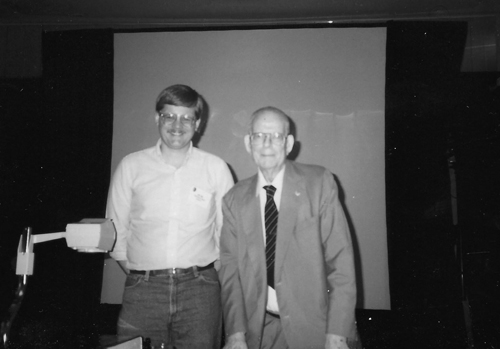
Author John Dyer with Dr. W. Edwards Deming in 1991
What are the characteristics of an outstanding leader? What does excellent leadership look like? Feel like? Sound like?
How much damage does an awful manager do to an organization? To the employees? To the customer relationship?
This book is for everyone current leaders and future leaders, those who are new in their career and those with several years of experience, people in manufacturing, the service industry, governments, hospitals, and non-profits. I believe that everyone will gain insight into the ways that managers and leaders are different and why it is important to the future success of your organization to fully understand these differences. My hope is that word will spread about the contents of this narrative and that the cultures of every organization will become a bit more focused on collaboration and teamwork. This is a dream I have had since my early days working at General Electric.
You will soon discover that this book is written in a style that is not the norm. Over the years, I have discovered that adults learn best when their imaginations are triggered. Throughout my time of writing articles for IndustryWeek magazine, I included a story based on real events followed by an analysis that would go into more depth on the key takeaways. When I was asked to turn some of these articles into a book, I decided to use this same style of writing. Each chapter begins with a narrative that involves two main characters: Frank Smith and Jim Brown. These two men are vice presidents in the fictional company known as JED, Inc. They both possess key characteristics of several people who I have worked for and with over the years. What occurs in the story portion of each chapter is based on actual events. Changes were made to protect the identity of the companies and people who were involved. Each chapter also contains an analysis of the narrative and provides practical applications.


